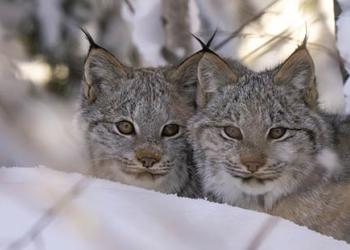Natural Resources
The Big Picture
In a global context, northeast Minnesota is in the southern edge of the boreal forest biome. The boreal biome is the largest biome in the world, crossing northern Asia, Europe, and North America.
The National Hierarchical Framework of Ecosystem Units classifies and maps ecological units based on associations of different factors. These factors include climate, topography, soils, water, and potential natural communities.
In the national ecological framework, Minnesota is at the western edge of the eastern block of Humid Temperate Domain. Minnesota is unique because it has three different ecological Divisions, meaning the State supports a diversity of natural communities. These ecological Divisions are Warm Continental, Hot Continental, and Prairie. The Superior NF is in the Warm Continental Division.
Integrated Vegetation Management
Through integrated vegetation management, wildlife, fire, silviculture, and timber specialists work together to ensure that the Forest is conserved, and restored while enhancing water resources. Integrated vegetation management involves Forest-wide long and short-term objectives, including:
- a greater mix of tree species, an increase in conifer and greater representation of older and multi-aged trees across the landscape
- habitat to maintain viability of species on the Federal endangered species list
- emphasis on managing for the entire spectrum of wildlife habitats, while still providing quality hunting experiences
Timber harvests and fire are primary treatment tools used to accomplish these objectives. By increasing acreage and size of vegetative treatments we are better able to mimic natural disturbances. Through the application of silvicultural practices we can control the establishment, growth, composition, health, and quality of forests.
The national forests do not exist within a vacuum but are part of a larger picture. Forest ecosystems and wildlife habitats cross political boundaries. As part of our integrated vegetation management, the Forest Service is committed to implementing and facilitating restoration of forested landscapes through an "all lands" approach that involves working with a broad range of partners, including federal, state, tribal, and private land owners as well as members of the public.
In support of the all lands approach, the Forest Service and Natural Resources Conservation Service, both agencies within the U.S. Department of Agriculture, are jointly investing funds and technical expertise to support ongoing efforts to restore and protect forest health, maintain clean water, and improve wildlife habitat in the North Shore Coastal Forest in northeast Minnesota. The Lake Superior North Shore Coastal Forest Restoration Project was selected under the USDA Joint Chief’s Collaborative Forest Landscape Restoration program.
Effective beginning 6/02/2025
This website, and all linked websites under the control of the agency is under review and content may change.
The Big Picture
In a global context, northeast Minnesota is in the southern edge of the boreal forest biome. The boreal biome is the largest biome in the world, crossing northern Asia, Europe, and North America.
The National Hierarchical Framework of Ecosystem Units classifies and maps ecological units based on associations of different factors. These factors include climate, topography, soils, water, and potential natural communities.
In the national ecological framework, Minnesota is at the western edge of the eastern block of Humid Temperate Domain. Minnesota is unique because it has three different ecological Divisions, meaning the State supports a diversity of natural communities. These ecological Divisions are Warm Continental, Hot Continental, and Prairie. The Superior NF is in the Warm Continental Division.
Integrated Vegetation Management
Through integrated vegetation management, wildlife, fire, silviculture, and timber specialists work together to ensure that the Forest is conserved, restored, and made more resilient to climate change while enhancing water resources. Integrated vegetation management involves Forest-wide long and short-term objectives, including:
- a greater mix of tree species, an increase in conifer and greater representation of older and multi-aged trees across the landscape
- habitat to maintain viability of species on the Federal endangered species list
- emphasis on managing for the entire spectrum of wildlife habitats, while still providing quality hunting experiences
Timber harvests and fire are primary treatment tools used to accomplish these objectives. By increasing acreage and size of vegetative treatments we are better able to mimic natural disturbances. Through the application of silvicultural practices we can control the establishment, growth, composition, health, and quality of forests.
The national forests do not exist within a vacuum but are part of a larger picture. Forest ecosystems and wildlife habitats cross political boundaries. As part of our integrated vegetation management, the Forest Service is committed to implementing and facilitating restoration of forested landscapes through an "all lands" approach that involves working with a broad range of partners, including federal, state, tribal, and private land owners as well as members of the public.
In support of the all lands approach, the Forest Service and Natural Resources Conservation Service, both agencies within the U.S. Department of Agriculture, are jointly investing funds and technical expertise to support ongoing efforts to restore and protect forest health, maintain clean water, and improve wildlife habitat in the North Shore Coastal Forest in northeast Minnesota. The Lake Superior North Shore Coastal Forest Restoration Project was selected under the USDA Joint Chief’s Collaborative Forest Landscape Restoration program.






